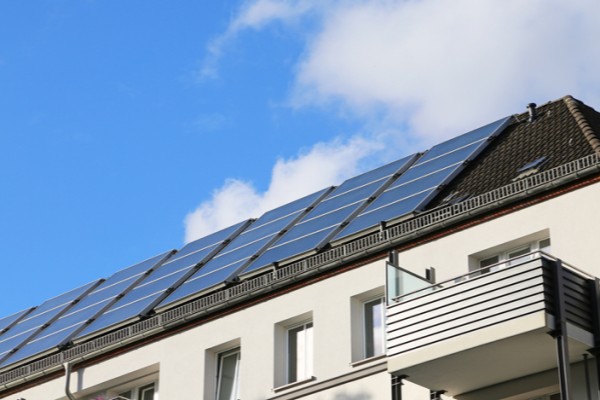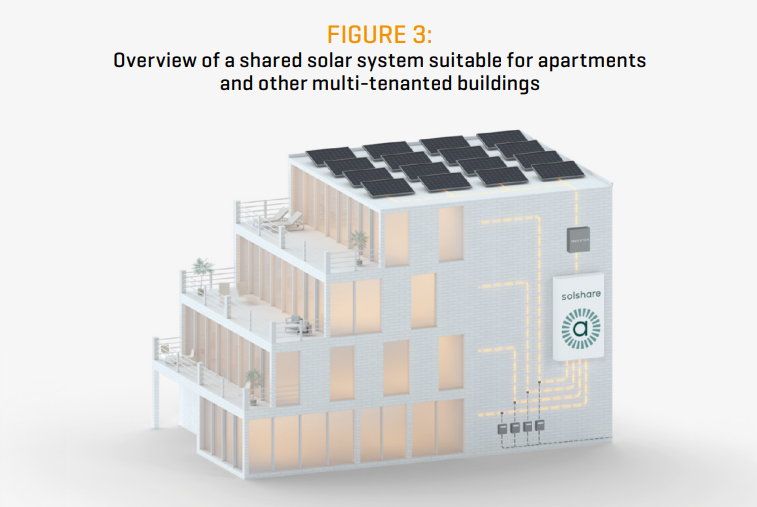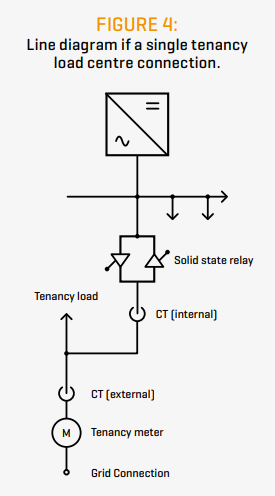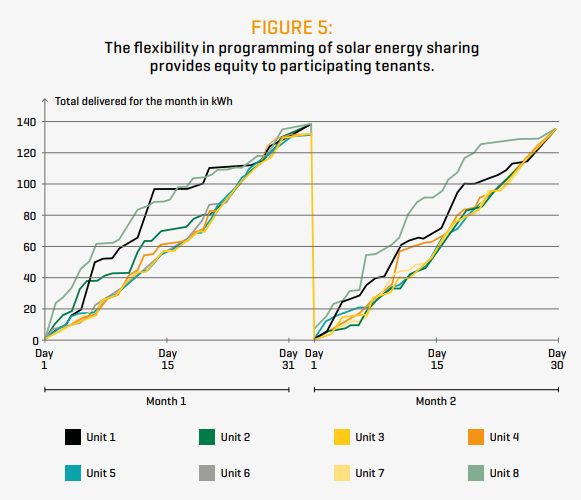Solar for apartments: A new opportunity for installers
Previously, installing solar panels on apartment complexes was too tall a task. Phil Kreveld explores how some changes are creating an opportunity in this area for installers.
The quarter-acre block with the Hills Hoist clothesline in the backyard is becoming an increasingly distant dream for many folk. We aren’t yet an apartment-dwelling people as in Europe, but high-density housing is gaining a level of acceptance, if by force through the rise in cost of dwellings on a typical suburban allotment.
ADVERTISEMENT
The clothes hoist in the yard can be replaced by a vented electric dryer, with a typical load consuming 6kWh (around $1.50 to $1.80), but without the benefit of offsetting the energy costs with solar panels if living in an apartment.
Solar for apartments face hurdles with body corporates and building owner associations, plus having to find suitable suppliers. And assuming all the stars have lined up so far, how will the cost of the installation be apportioned, and how do the individual occupiers get justly awarded with reductions in their electricity bills?
For you, the contractor, is solar for apartments best left to someone else? The suggestion is that you inform yourself because it’s a legitimate business opportunity with some 1.7 million apartment buildings around Australia, and most without solar as yet.
A combination of demands for affordable housing, ready access to transport and other infrastructure, and downward pressure on energy costs creates a market for this new version of domestic rooftop solar. The market in Australia is still modest, but a moment’s reflection increases the scope from apartment buildings to shopping complexes, multipurpose buildings, etc.
In fact, the 2024 edition of AS/NZS 4777.1 anticipates this newer business area, classified inverter power sharing devices (IPSD), and termed as: “Devices used to share the supplementary supply from an inverter or multiple inverters to provide supplementary supplies to a number of electrical installations that are part of a multiple electrical installation, weather patterns and tenants’ energy behaviour.”
All IPSD installations must comply with:
• Electricity Safety Act 1998
• Electricity Safety (General) Regulations 2019
• Electricity Safety (Registration and Licensing) Regulations 2020
• AS/NZS 4777.1:2024 Grid connection of energy systems via inverters
• AS/NZS 5033:2021 Installation and safety requirements for photovoltaic (PV) arrays
• AS/NZS 3000:2018 Electrical installations (known as the Australian/New Zealand Wiring Rules).
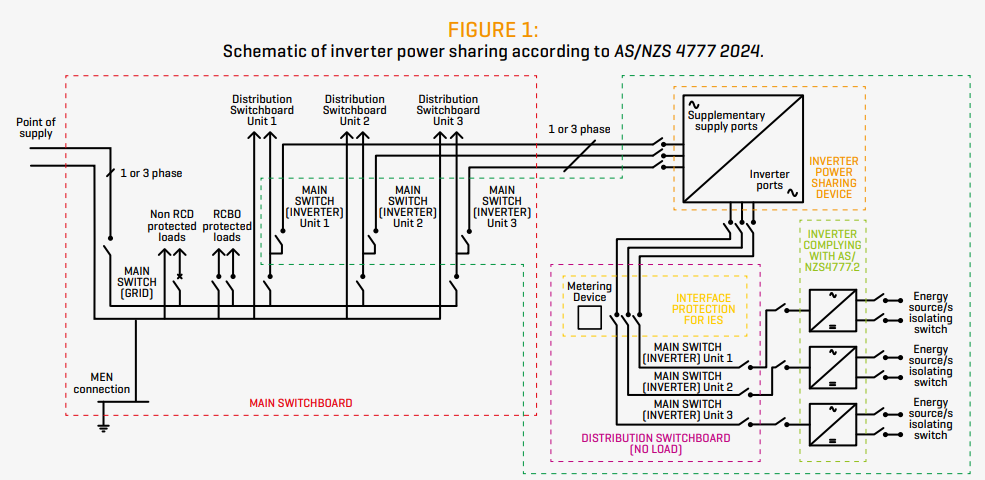 Statistics for apartment buildings are difficult to come by. A bit of Googling reveals at least a rough shape of the potential market. According to Dr Jemma Green, a post-doctoral research fellow at Curtin University’s Sustainability Policy Institute, apartment buildings represented around 32% of the housing stock in Australia. Broken down by the largest cities:
Statistics for apartment buildings are difficult to come by. A bit of Googling reveals at least a rough shape of the potential market. According to Dr Jemma Green, a post-doctoral research fellow at Curtin University’s Sustainability Policy Institute, apartment buildings represented around 32% of the housing stock in Australia. Broken down by the largest cities:
- Greater Melbourne: Private dwellings, two million; 25,000 apartment buildings.
- Greater Sydney: Private dwellings, two million: 120,000 apartment buildings.
- Greater Brisbane: Private dwellings, one million: 84,000 apartment buildings.
- Canberra: 32,000 ‘high density’ apartments (i.e., not known as to the number of buildings).
- No data available for Adelaide and Perth.
Other than for single-level accommodation, where often as not individual occupiers can choose to install their own solar, or two-level constructions with sufficient roof area, mostly a physical restriction limits the opportunity to provide solar energy for every occupant in multi-tenanted premises.
As buildings increase in height, the volumetric energy requirement per apartment is increasingly limited by available roof area, and thus only provides energy consumption relief for common areas, including lighting and mechanical services. There are some solutions, such as lightweight and flexible solar panels with mini-inverters that can be plugged into wall sockets. Germany apparently has regulations covering these products, but they are not allowed here and in many other countries because of electrical safety concerns. Therefore, hobbyist solutions other than those that comply with electrical safety regulations are unlikely to impact this new market.
For central solar systems providing for all residents, power limitations of 30kW based on the DC output of panels limit the number of apartments per inverter.
Obviously, for larger low-level constructions, residential energy requirements can be catered for via parallel systems. An immediate question that arises from communal solar systems is metering and equitable split-ups of generated energy. As in individual solar installations, generated energy is supplied behind the revenue meter, but how to allocate a reapportionment of solar-generated energy based on individual residents’ electricity bills.
Practically, this would be an accounting mess, arranging for credits to individual residents. Embedded metering can solve this problem in that the NMI registered party receives the net energy bill, and then bills individual apartments, tenancies, etc. via their individual private metering. Embedded networks are no longer permitted in Victoria on the basis of not allowing individual energy consumers to find the most economical electrical energy retailer.
A means for individual allocation of solar panel-generated energy is available with SolShare, technology developed by the Australian company, Allume. In principle, the output of a solar inverter is apportioned to individual load centres via their own dedicated circuits with power-flow controlled by switched, solid-state relays.
The advantages of the technology lie in the use of algorithms, controlling the switching on and off of solar power to individual tenancies. These provide split-ups based on individual demand, rewarding high energy users, or more equitable split-ups based on pre-agreed percentages of solar energy generated.
We go into more detail further down, but in the preparation of this article, it appeared that the Allume technology may be in a classification of its own. This is not to indicate that it is a unique solution because there is, for example, the micro-inverter option dedicated to individual tenancy solar panel-strings. In the preparation of this article, a Melbourne-based contractor, Helcro Solar, mentioned pricing a central inverter system against a micro-inverter solution, with the latter being more economical for a particular small apartment block.
Note, however, that as illustrated by Figure 2, the SolShare claim of a superior return on investment is based on a more efficient utilisation of solar energy than is achievable with a single, dedicated PV system.
Apartment blocks, even smaller ones, with ten or so tenancies will be connected to three-phase so as to provide a modicum of phase balance, a problem that, if anything, is a growing one in distribution networks. SolShare assists phase balance because the three-phase inverter, usually rated at 20kW, has its output shared on the basis of five load centres per phase.
The programming flexibility, therefore, allows a more efficient sharing of solar energy than is possible with single installations. As is evident, a much more efficient use is made of available energy by virtue of programmable apportionment of available energy so that solar energy can be sent to loads capable of absorbing energy, rather than sending it down the pike for no recompense or some miserable feed-in tariff.
The solar installation technical requirements for apartments are relatively straightforward, the main one being that tenancy revenue meters be in a central place so as to limit wiring and ducting costs. Obviously, each apartment receives its own electricity bill and feed-in credit, if applicable. Figure 2 indicates the basic wiring schematic of a typical tenancy.
Note the use of so-called ‘internal’ current transformers, i.e., within the SolShare and external CTs placed between the inverter power feed-in to each apartment and its revenue meter.
The internal CT permits computation of solar power (note: power is computed utilising internal chips), and external, clamp-on CT simultaneously facilitate computation of grid power input or ‘output’ (i.e., feed-in). The dual power measurement is critical to the allocation of solar energy benefits to tenancies.
Every 200ms, the five solar power inputs per phase have power input (via internal CT) and external power from (or to) the grid (via external CT) measured, thus allowing for watertight accounting of solar benefits for each tenancy.
Note that at all times, the three-phase inverter, being a grid-following device, requires the presence of three-phase voltage for its phase-locked loop to operate correctly, and for the prevention of incorrect anti-islanding operation.
The granularity provided by the 200ms cycle in energy sharing permits great flexibility in programming. Apportionment for individual apartments is based on energy provided and net energy usage. This permits rebalancing before the end of the monthly accounting cycle and thus making provision for vacant and lightly occupied tenancies. The use of storage batteries is possible by means of hybrid connections. A buck converter, as an integral part of the maximum power point tracker, reduces the panel voltage to battery level. The battery feeds the boost converter to supply the DC link of the inverter.
According to Allume, a typical installation, all up, and including small certificate credits, is typically of the order of $4,000, but this figure obviously depends on a number of individual apartment physical construction features. That would seem to allow a good sales argument for many apartment dwellers.
Apparently, the United Kingdom is currently the main market for the company. That is not so surprising, given Australia’s fondness for ‘detached’ living. However, a reasonable prediction of the future indicates that higher-density living is on the cards. Not only are apartments candidates, but future developments with building-integrated PV may well expand the market for solar sharing. BIPV takes the pressure of the limitations of roof space by utilising solar cells in curtain walls, and generally in building façades.
-
ADVERTISEMENT
-
ADVERTISEMENT

